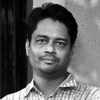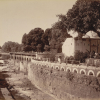My native place, Sindhudurg, is the southernmost district in Maharashtra, bordering Goa. The Konkan coast here has long been visited by Arabs, who were the dominant traders before the arrival of the Europeans. Arabs were involved in the slave trade—they had colonised the eastern coastline of Africa, where they captured African natives, auctioned them at slave markets and transported them across the Indian Ocean to buyers in India. Africans were considered physically strong and tough, making them valuable human resources for physical labour and soldiers. Much of the Arab slave trade happened from Abyssinia, today’s Ethiopia and Eritrea, hence these African slaves were called Habshi in India, derived from Arabic for Abyssinia (al-Habash). African-descent people are also known as Siddis in India, though its origin is unknown.
In India, some Siddi slaves were freed, and their military prowess helped them rise up the ranks to positions of power in medieval India. In the sixteenth century, a slave-turned-mercenary from Ethiopia, Malik Ambar, rose to the position of peshwa of the Ahmednagar Sultanate. A pioneer of guerilla warfare, he constantly harassed neighbouring Bijapur, laying the foundation for the later rise of the Marathas under Chhatrapati Shivaji Maharaj. He also kept the Mughals away from the Deccan—much to the annoyance of Mughal Emperor Jahangir. On the Arabian Sea, Malik Ambar fortified an island off Murud, in the present-day Raigad district of Maharashtra. This sea fort, Janjira, is a marvel of naval architecture and became an impregnable Siddi stronghold from where they repelled the Portuguese and British and successfully defended against Maratha attacks from the mainland. The Siddis of Janjira proved to be skilled mariners, and their naval services were much sought after by the Mughals and the Ottomans. As their power increased, the Janjira Siddis expanded territory on land. At its peak expansion, they captured as many as 22 land forts. During the British period, Murud-Janjira was an 11-gun salute princely state. It merged with India in 1948.
Along the Konkan coast, Siddis also lived in Goa, where they worked as labourers. Unlike Siddis in other parts of India who originated from Abyssinia, these Siddis were descendants of Bantu people. The Portuguese had colonised Mozambique, from where they inherited the Arab slave trade along the Swahili coast. They brought Africans to Goa when it was a Portuguese colony. When Goa was liberated in 1960, the Siddis were left behind. This didn’t go well with locals who had to compete with Siddis for labour jobs. There were constant conflicts between the two groups, which led to the Siddis taking refuge in the forests of the Western Ghats. Many Siddis had earlier fled to Karnataka to escape persecution during the infamous Goan Inquisition.
In Karnataka, the Siddis engaged themselves in agriculture in and around Yellapur, Mundgod, Haliyal, Sirsi and Ankola in Uttar Kannada district, and other places in Belgaum, Dharwad and Haveri districts. They assimilated themselves into the Konkani culture by adopting local sensibilities and customs. Over time, they even lost proficiency in their mother tongue and began speaking Indian languages like Kannada, Marathi, Konkani and Hindi. Again, intermarriage with Indians has resulted in racially mixed generations, though they retain African features. Even their attires and names have been Indianised. A majority of the Siddi population follow Hinduism, but there are significant followers of Islam and Christianity as well. But the religion they follow is just for formality; Siddis intermarry across religions without any reservations. Their Siddi surname is the same for all religions. Siddis have retained Hiriyaru (ancestor worship), and on occasions like births, marriages and deaths, the spirits of their ancestors are invoked. Siddis have also retained their African heritage through music and dance. Dammam is a traditional Siddi dance form, accompanied by the playing of ngoma drums. The dance has similarities to African dance movements. They sing and dance the whole night during festivals or on family occasions. Men play music while the women sing and dance. It brings the entire community together.
However, one may ask, even though Siddis have a long and distinguished history in India, have they been accepted by Indians? The answer is ‘NO’. Even today, a Siddi is recognised as African, not Indian. Their social integration has been a failure. It is not easy for them to find jobs outside of their community. Though in 2003 they were listed by the Indian Government as a Scheduled Tribe, they have lacked social mobility or economic empowerment. Even in cities, they are looked down upon and find it near impossible to land a decent job. Although they speak Indian languages, due to their physical appearance, they are considered ‘outsiders’. This racist attitude leads to the non-acceptance of their nationality as Indians. They continue to remain an invisible community on the fringes of society, tucked away in remote villages or in the forests.
In the last couple of decades, with the advent of computers, mobile phones and the Internet, there has been but a slow change in the community. The earlier generation of Siddis had no idea why they had dark skin, why they had curly hair or why their physique was different from any other Indians. This gave rise to an identity crisis. But access to information has made Siddis recognise their African roots, and the new generation has accepted their identity, their rich heritage. Even if it is slow, the process has definitely begun. One new career opportunity they are exploring is sports. Because of African genes, Siddi youngsters are blessed with good stamina, physique, body strength and power, and they are making a mark in athletics and sports, like football, volleyball and kabaddi.
I met Anita in Hunashettikoppa, a small village in the Haveri district. Anita is a sprinter; a fan of Usain Bolt. She has won numerous awards in 500, 800 and 1000 meters middle-distance running. When I asked if I could see her medals, her mother climbed the attic and threw down a bunch of rusty medals. She washed them and handed them to me. Not just at Anita’s home, in almost all Siddi homes I visited, there were at least two people in the family who had excelled in sports. The shelves in their homes are crowded with trophies, shields and medals. However, once they reach senior level, they can’t break the glass ceiling. This is why we hardly see Siddis in national teams despite them excelling in sports at junior levels. Not just racism, but generational poverty also restricts their pursuit of sports as a career.
Other debilitating factors hindering their social empowerment has been a lack of education, infrastructure and political representation. Travelling and staying in big cities is simply beyond their financial capacity. I visited Salvin’s cousin, Priyanka. She was away studying in Mangalore, at one of the most prestigious colleges there. This was a huge achievement in her community. There was a picture of Priyanka with her two friends framed in the living room. It was heartening to see the friends in the picture were not from the Siddi community. I read a quote on the picture frame, which said, ‘One word frees us of all weight and pain in life. That word is love.’ This line says it all. Acceptance of Siddis as Indians is the only way this change can come about. That onus is on all Indians. Even if the change is slow, I hope and wish it happens in the future. It is high time the Siddis represent India at the highest level, not only in sports but in all other walks of life, as their ancestors did in the past.
This photo-essay has been created as part of the Sahapedia Frames Photography Grant, supported by CSR funding from IndusInd Bank.

















